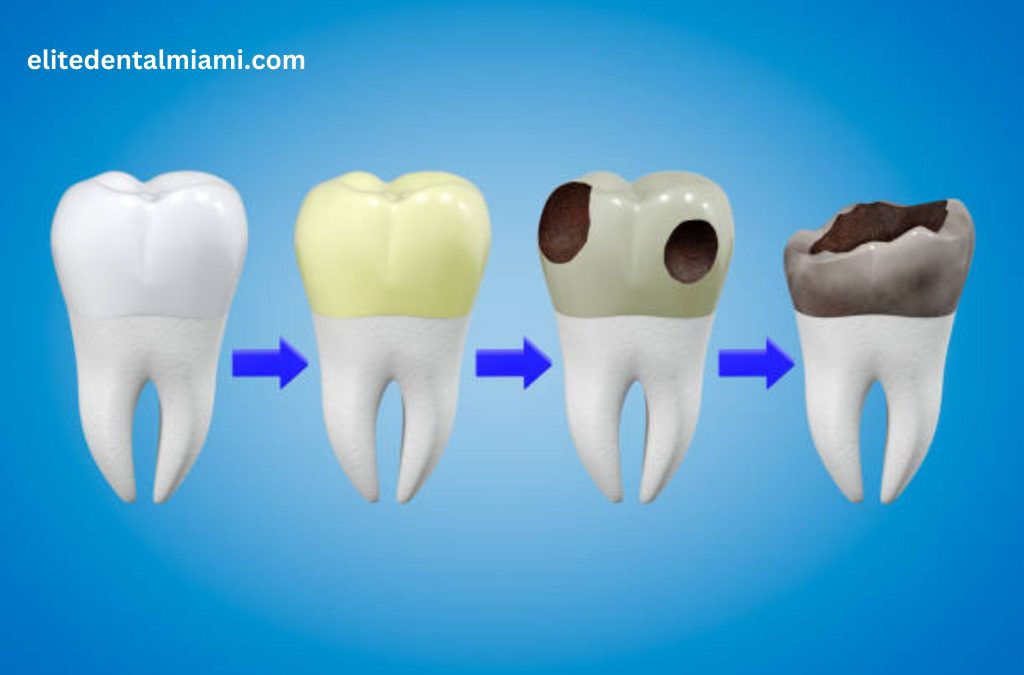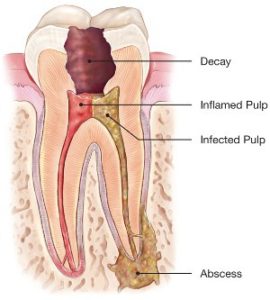A root canal involves the removal of infected pulp and nerve in the tooth’s root, followed by cleaning, shaping, filling, and sealing of the canal. Afterward, a crown is placed on the tooth for protection and restoration.
A root canal is a dental procedure that is performed to save a tooth from extraction. It involves removing the infected pulp and nerve within the tooth’s root. This procedure is necessary when the pulp becomes infected or damaged due to tooth decay, trauma, or infection.
Root canals are typically performed by an endodontist, a dentist who specializes in treating the inside of the tooth. During the procedure, the endodontist will clean and shape the inside of the root canal and then fill and seal the space. After the root canal, a crown is usually placed on the tooth to restore its function and protect it from further damage. While root canals may seem intimidating, they are actually a common and effective way to save a tooth and alleviate pain.

What Is A Root Canal?
In dentistry, a root canal is a procedure used to repair and save a tooth that is badly decayed or becomes infected. A root canal operation involves removing the nerve and pulp from the tooth and cleaning and sealing the interior. This helps in preventing the development of a painful infection which may lead to the loss of the tooth.
Definition
The phrase root canal refers to the natural cavity located in the core of the tooth. The pulp chamber is the soft part of the root canal.
Procedure
The procedure typically involves several steps:
- Firstly, an opening is made through the crown of the tooth into the pulp chamber.
- The length of the root canals is determined.
- The unhealthy pulp is removed, and the other canals are prepared for filling.
- The canals are then filled with a biocompatible material and sealed.
- The tooth is clean, and a temporary or permanent filling or crown is placed.
Purpose
The primary purpose of a root canal is to save a tooth that is infected or badly decayed. By removing the infected pulp, bacteria, and other debris, the tooth can be preserved and prevent the need for extraction.
What Does A Root Canal Look Like?
A root canal can look like a healthy, white, and cavity-free tooth on the outside, but on the inside, it may be infected and painful until treated. The procedure involves removing the infected pulp and nerve, cleaning and shaping the root canal, and then sealing it.
A crown is typically placed on the tooth to protect and restore its original function.
Appearance Of A Healthy Tooth
A healthy tooth is usually white, clean, and free of cavities. It looks similar to a root canal-treated tooth. The visible part of the tooth, known as the crown, should have a smooth surface without any discoloration or cracks. A healthy tooth appears intact and is firmly anchored in the gums. It functions properly without causing any pain or discomfort.
Appearance Of An Infected Tooth
An infected tooth can have a range of noticeable changes in appearance. Some common signs include:
- Persistent pain: A tooth with an infected root canal may cause persistent tooth pain.
- Sensitivity to heat and cold: An infected tooth can become extremely sensitive to hot and cold temperatures.
- Tooth discoloration: The infected tooth may appear darker or have a grayish hue compared to the surrounding teeth.
- Swollen gums: Inflammation or swelling of the gums around the infected tooth is a common indicator of an infected root canal.
- Pain when eating or touching the tooth: Increased sensitivity or pain when applying pressure to the tooth can be a sign of an infected root canal.
- A chipped or cracked tooth: In some cases, an infected root canal may result from a chipped or cracked tooth.
- Tooth mobility: An infected root canal may cause the affected tooth to become loose or mobile.
X-ray Images
X-ray images play a crucial role in diagnosing and visualizing the condition of the tooth’s root canal. They are used by dentists and endodontists to identify infection, damage, or other abnormalities within the root canal and surrounding structures. X-rays can show the shape, length, and depth of the root canal, as well as any signs of infection or damage that may not be visible to the naked eye.
In conclusion, a root canal can be difficult to visually identify without professional expertise. However, the appearance of a healthy tooth, the signs of an infected tooth, and the use of X-ray images are all essential for diagnosing and treating root canal issues effectively.
Signs and Symptoms of a Root Canal
Troubling signs such as persistent pain, heat and cold sensitivity, tooth discoloration, and swollen gums could indicate a need for a root canal. Root canals may appear white, clean, and cavity-free from the outside, but internal infection can cause discomfort until treatment.
Signs and Symptoms of a Root CanallPersistent Tooth Pain Persistent tooth pain is one of the most common signs that you may need a root canal. If you are experiencing constant, throbbing pain in a specific tooth that doesn’t go away with over-the-counter pain medication, it could be an indication that the pulp inside the tooth is infected or inflamed. This pain may worsen when you bite down or apply pressure to the tooth.
Sensitivity to Heat and Cold Another sign that you may need a root canal is sensitivity to heat and cold. If you find yourself wincing or experiencing sharp pain when you consume hot or cold beverages or food, it could be a sign that the nerve inside the tooth is damaged or infected. This sensitivity may linger even after the hot or cold stimulus is removed.
Tooth Discoloration Tooth discoloration can also be an indicator that you may need a root canal. If you notice that a tooth is becoming darkened or turning a grayish-black color, it may be due to the death or decay of the blood vessels and nerves inside the tooth. This discoloration is a result of the breakdown of these internal structures, and a root canal may be necessary to remove the infected pulp and restore the tooth’s appearance.
Swollen Gums Swollen gums around a specific tooth can be a sign that a root canal is needed. If you notice redness, tenderness, or swelling in the gums near a tooth, it may be an indication that the tooth’s pulp is infected. The swelling is a result of the body’s immune response to the infection, and a root canal can help eliminate the source of the inflammation and restore gum health.
Pain When Eating or Touching the Tooth Pain when eating or touching the tooth is another symptom of needing a root canal. If you experience sharp or intense pain when chewing or when pressure is applied to a specific tooth, it could be a sign that the pulp inside the tooth is infected or damaged. This pain may also be accompanied by sensitivity to heat and cold or constant toothache. If you are experiencing any of these signs and symptoms, it is important to consult with a dentist as soon as possible. They will be able to evaluate your condition and determine if a root canal procedure is necessary to restore your oral health and alleviate your discomfort. Remember, early intervention can prevent further complications and preserve your natural tooth.

Credit: www.putneydentalcare.com.au
Is A Root Canal Painful?
A root canal treatment is not painful and can save a tooth from being completely removed. On the outside, it may look like a healthy tooth, but on the inside, it can be infected and cause pain until treated.
Is a Root Canal Painful? H3 headings: Pain During the Procedure Post-Procedure Pain A common concern for many individuals facing a root canal is the potential pain associated with the procedure. Contrary to popular belief, root canal treatment is not particularly painful. Understanding what to expect during the procedure and the discomfort that may follow can help alleviate any fears or anxiety surrounding a root canal.
Pain During the Procedure During the root canal procedure, local anesthetics are used to ensure that the tooth and the surrounding area are completely numb. This effectively minimizes any discomfort or pain during the treatment. The endodontist will remove the infected pulp, clean and shape the root canal, and then fill and seal it. Patients may only experience slight pressure or vibrations during the procedure, but not pain.
Post-Procedure Pain After the root canal, it is common to experience some tenderness and discomfort. This is typically manageable with over-the-counter pain medications such as ibuprofen or acetaminophen. In some cases, the dentist may prescribe stronger pain medication if necessary.
The discomfort should gradually subside within a few days as the inflammation decreases, allowing the tooth to heal. It’s essential to follow the dentist’s post-procedure instructions, such as avoiding chewing on the treated tooth until the permanent crown is placed. In summary, while the anticipation of pain during a root canal may create anxiety, the procedure itself is not inherently painful. Understanding the process and the potential discomfort post-procedure can help ease any concerns.
Before And After Of A Root Canal
A root canal procedure involves removing infected pulp and nerve from the root of the tooth, cleaning and shaping the canal, and then filling and sealing it. Afterward, a crown is placed to protect and restore the tooth’s function. A healthy root canal can look like a white, clean, and cavity-free tooth.
Cracked Or Chipped Tooth
One common reason for needing a root canal is a cracked or chipped tooth. When a tooth becomes cracked or chipped, it can expose the delicate pulp inside the tooth, which can lead to infection and decay. This is where a root canal comes in. During a root canal procedure, the dentist will remove the damaged pulp, clean and shape the root canal, and then seal it to prevent further damage.
Inflamed Or Darkened Gums
Inflamed or darkened gums are another indication that a root canal may be needed. When the pulp inside the tooth becomes infected, it can cause the gums to become inflamed and appear darker in color. This inflammation and discoloration is a result of the body’s immune response to the infection. By undergoing a root canal, the infected pulp can be removed, allowing the gums to heal and return to their normal, healthy state.
X-ray Images Of Completed Root Canal
X-ray images are an essential tool in diagnosing and completing a root canal procedure. These images allow the dentist to see the extent of the damage to the tooth and determine the best course of action. After the root canal is completed, new X-ray images are taken to ensure that the entire root canal system has been thoroughly cleaned and sealed. These images provide a clear picture of the tooth’s health before and after the root canal treatment.

Credit: www.aae.org
Frequently Asked Questions Of What Root Canal Looks Like
What Comes Out During Root Canal?
During a root canal, the endodontist removes infected pulp and nerve, cleans and shapes the root canal, and then fills and seals it. Afterward, a crown is placed on the tooth for protection and restoration.
What Does A Tooth Look Like With A Root Canal?
A tooth with a root canal can look like a healthy tooth – white, clean, and without cavities. However, on the inside, the tooth may be infected and painful until treated. The dentist will remove the infected pulp and nerve, clean and fill the root canal, and then place a crown on the tooth for protection and restoration.
How Do You Know If You Are Getting A Root Canal?
You may be getting a root canal if you experience persistent tooth pain, sensitivity to heat and cold, tooth discoloration, swollen gums, pain when eating or touching the tooth, a chipped or cracked tooth, or tooth mobility. Root canal treatment is not painful and can save a tooth that would otherwise need to be removed.
Is It Painful To Have A Root Canal?
A root canal treatment is not usually painful and can save a tooth from removal.
Conclusion
Root canals may appear similar to healthy teeth from the outside, but can be infected and painful internally without proper treatment. By removing infected pulp and sealing the space, a root canal can save a tooth and restore its function.
Understanding root canal procedures and symptoms is crucial for dental health.

I am a dentist and also blog regularly. my target audience is America Europe & providing regular information for them.
